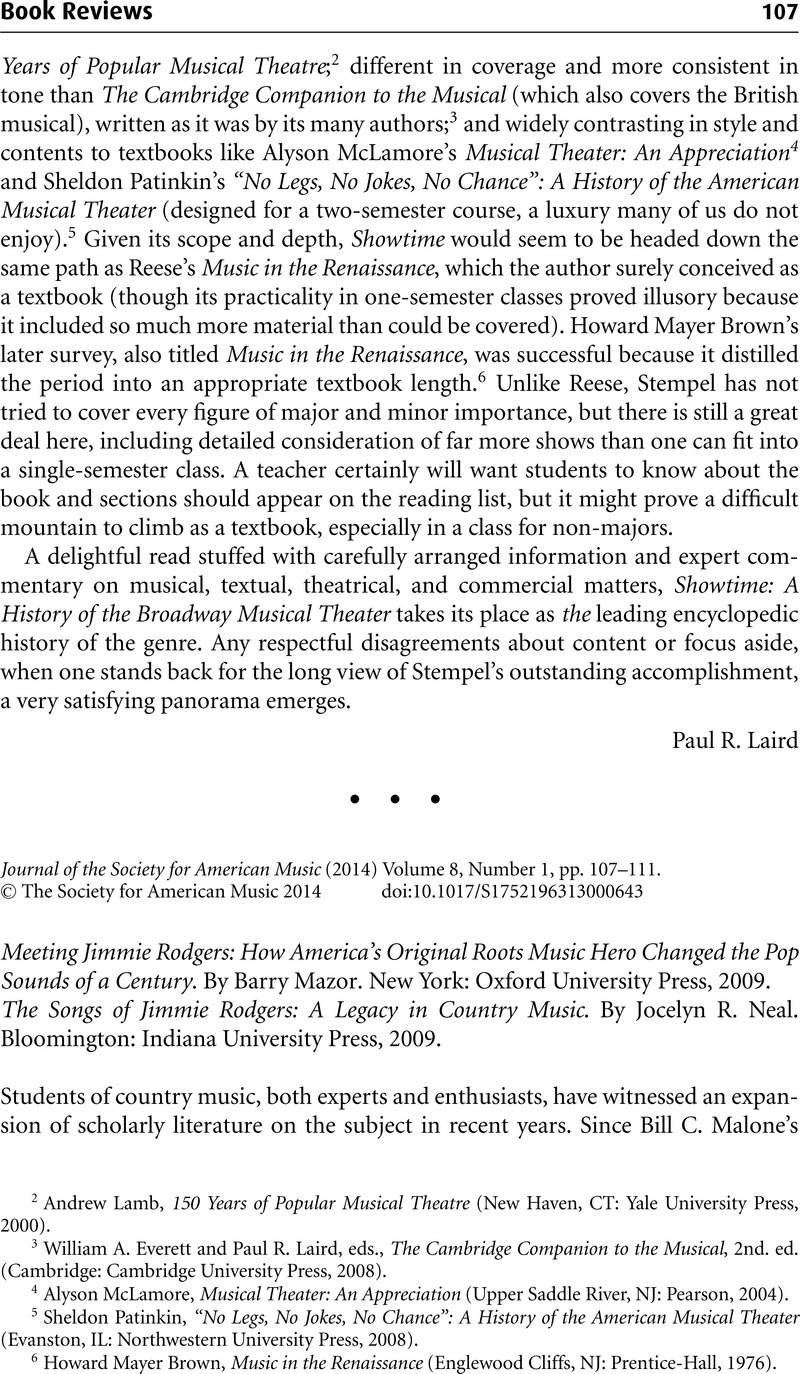No CrossRef data available.
Article contents
Meeting Jimmie Rodgers: How America's Original Roots Music Hero Changed the Pop Sounds of a Century. By Barry Mazor. New York: Oxford University Press, 2009. - The Songs of Jimmie Rodgers: A Legacy in Country Music. By Jocelyn R. Neal. Bloomington: Indiana University Press, 2009.
Published online by Cambridge University Press: 12 March 2014
Abstract

- Type
- Book Review
- Information
- Copyright
- Copyright © The Society for American Music 2014
References
1 Mazor has been a senior editor for No Depression magazine and a contributor to the Wall Street Journal, the Village Voice, the Nashville Scene, American Songwriter, and the Journal of Country Music.
2 See also Neal, Jocelyn R., “Popular Music Analysis in American Music Theory,” Zeitschrift der Gesellschaft für Musiktheorie 2/2 (2005): 173–80Google Scholar. Neal has published extensively on country music, including a recent textbook. See Neal, , Country Music: A Cultural and Stylistic History (New York: Oxford University Press, 2012)Google Scholar.
3 Porterfield, Nolan, Jimmie Rodgers: The Life and Times of America's Blue Yodeler (Urbana: University of Illinois Press, 1979Google Scholar; reprint ed., Jackson: University Press of Mississippi, 2007); Malone, Bill C. and Neal, Jocelyn R., Country Music U.S.A, 3rd ed. (Austin: University of Texas Press, 2010)Google Scholar; Russell, Tony, Blacks, Whites, and Blues (New York: Stein and Day, 1970)Google Scholar, republished with additional commentary in Oliver, Paul, Russell, Tony, Dixon, Robert M. W., and Godrich, John, Yonder Come the Blues: The Evolution of a Genre (Cambridge: Cambridge University Press, 2001)Google Scholar; Paris, Mike and Comber, Chris, Jimmie the Kid: The Life of Jimmie Rodgers (New York: Da Capo Press, 1977)Google Scholar; and Wolfe, Charles K. and Olson, Ted, eds., The Bristol Sessions: Writings about the Big Bang of Country Music (Jefferson, NC: McFarland, 2005)Google Scholar. Writings on Rodgers by Malone, Porterfield, Wolfe, Russell, Neal, Mazor, and others are also included in Davis, Mary and Zanes, Warren, eds., Waiting for a Train: Jimmie Rodgers's America (Burlington, MA: Rounder Books, 2009)Google Scholar, a publication of the Rock and Roll Hall of Fame and Museum's American Music Masters Series.
4 Neal's book The Songs of Jimmie Rodgers is a reworking of her 2002 dissertation. See Neal, “Song Structure Determinants: Poetic Narrative, Phrase Structure, and the Hypermeter in the Music of Jimmie Rodgers,” (Ph.D. diss., Eastman School of Music, 2002).
5 Mazor draws most directly from Bart Plantenga's Yodel-Ay-Ee-Oooo: The Secret History of Yodeling Around the World (New York: Routledge, 2004).
6 Mazor cites Tosches, Nick, Where Dead Voices Gather (New York: Little, Brown, 2001)Google Scholar.
7 Nick Tosches, “Jimmie Rodgers and ‘The Famous Yodeling Blues Singer’ of 1926,” in Davis and Zanes, eds., Waiting for a Train, 37. Tosches's final paragraph of his essay is telling: “Facts may be meaningless and facts may say much. But here are some facts to ponder: In the spring and hot days of 1926, Jimmie Rodgers, struggling to get by, had not yet made a record. During that time, Emmett Miller was the ‘Famous Yodeling Blues Singer.’ Within two years, Miller was descending, and his title of glory, the ‘Famous Yodeling Blues Singer,’ was all but forgotten. Jimmie Rodgers, ascending, was now celebrated as ‘America's Blue Yodeler’” (43).
8 The concept of a “song family” is a fitting paradigm when discussing such repertory, where “after a few subsequent reworkings, little musical substance may be left of the original” (15). The “song family” concept was first adopted by Hatch, David and Millward, Stephen in From Blues to Rock: An Analytic History of Pop Music (Manchester: Manchester University Press, 1987), 2Google Scholar.




